Requirement for enhancer specificity in immunoglobulin heavy chain locus regulation
- PMID: 18490744
- PMCID: PMC2408828
- DOI: 10.4049/jimmunol.180.11.7443
Requirement for enhancer specificity in immunoglobulin heavy chain locus regulation
Abstract
The intronic Emicro enhancer has been implicated in IgH locus transcription, VDJ recombination, class switch recombination, and somatic hypermutation. How Emicro controls these diverse mechanisms is still largely unclear, but transcriptional enhancer activity is thought to play a central role. In this study we compare the phenotype of mice lacking the Emicro element (DeltaEmicro) with that of mice in which Emu was replaced with the ubiquitous SV40 transcriptional enhancer (SV40eR mutation) and show that SV40e cannot functionally complement Emu loss in pro-B cells. Surprisingly, in fact, the SV40eR mutation yields a more profound defect than DeltaEmicro, with an almost complete block in micro0 germline transcription in pro-B cells. This active transcriptional suppression caused by enhancer replacement appears to be specific to the early stages of B cell development, as mature SV40eR B cells express micro0 transcripts at higher levels than DeltaEmicro mice and undergo complete DNA demethylation at the IgH locus. These results indicate an unexpectedly stringent, developmentally restricted requirement for enhancer specificity in regulating IgH function during the early phases of B cell differentiation, consistent with the view that coordination of multiple independent regulatory mechanisms and elements is essential for locus activation and VDJ recombination.
Figures





Similar articles
-
Complete cis Exclusion upon Duplication of the Eμ Enhancer at the Immunoglobulin Heavy Chain Locus.Mol Cell Biol. 2015 Jul;35(13):2231-41. doi: 10.1128/MCB.00294-15. Mol Cell Biol. 2015. PMID: 25896912 Free PMC article.
-
Enhancers located in heavy chain regulatory region (hs3a, hs1,2, hs3b, and hs4) are dispensable for diversity of VDJ recombination.J Biol Chem. 2012 Mar 9;287(11):8356-60. doi: 10.1074/jbc.M112.341024. Epub 2012 Jan 23. J Biol Chem. 2012. PMID: 22270371 Free PMC article.
-
Regulation of IgH gene assembly: role of the intronic enhancer and 5'DQ52 region in targeting DHJH recombination.J Immunol. 2006 Feb 15;176(4):2439-47. doi: 10.4049/jimmunol.176.4.2439. J Immunol. 2006. PMID: 16456003
-
Epigenetic features that regulate IgH locus recombination and expression.Curr Top Microbiol Immunol. 2012;356:39-63. doi: 10.1007/82_2011_153. Curr Top Microbiol Immunol. 2012. PMID: 21779986 Review.
-
Long-Range Control of Class Switch Recombination by Transcriptional Regulatory Elements.Front Immunol. 2021 Sep 14;12:738216. doi: 10.3389/fimmu.2021.738216. eCollection 2021. Front Immunol. 2021. PMID: 34594340 Free PMC article. Review.
Cited by
-
Fc Receptor-Like 6 (FCRL6) Discloses Progenitor B Cell Heterogeneity That Correlates With Pre-BCR Dependent and Independent Pathways of Natural Antibody Selection.Front Immunol. 2020 Feb 14;11:82. doi: 10.3389/fimmu.2020.00082. eCollection 2020. Front Immunol. 2020. PMID: 32117244 Free PMC article.
-
Complex oncogenic translocations with gene amplification are initiated by specific DNA breaks in lymphocytes.Cancer Res. 2009 May 15;69(10):4454-60. doi: 10.1158/0008-5472.CAN-08-4515. Epub 2009 May 12. Cancer Res. 2009. PMID: 19435904 Free PMC article.
-
Discovery platform for inhibitors of IgH gene enhancer activity.Cancer Biol Ther. 2019;20(4):571-581. doi: 10.1080/15384047.2018.1538615. Epub 2018 Nov 27. Cancer Biol Ther. 2019. PMID: 30481117 Free PMC article.
-
Genome-Wide Mapping of Collier In Vivo Binding Sites Highlights Its Hierarchical Position in Different Transcription Regulatory Networks.PLoS One. 2015 Jul 23;10(7):e0133387. doi: 10.1371/journal.pone.0133387. eCollection 2015. PLoS One. 2015. PMID: 26204530 Free PMC article.
-
Genome Instability in Multiple Myeloma: Facts and Factors.Cancers (Basel). 2021 Nov 26;13(23):5949. doi: 10.3390/cancers13235949. Cancers (Basel). 2021. PMID: 34885058 Free PMC article. Review.
References
-
- Ernst P, Smale ST. Combinatorial regulation of transcription II: The immunoglobulin mu heavy chain gene. Immunity. 1995;2:427–438. - PubMed
-
- Bottaro A, Young F, Chen J, Serwe M, Sablitzky F, Alt FW. Deletion of the IgH intronic enhancer and associated matrix-attachment regions decreases, but does not abolish, class switching at the mu locus. Int Immunol. 1998;10:799–806. - PubMed
Publication types
MeSH terms
Substances
Grants and funding
LinkOut - more resources
Full Text Sources
Other Literature Sources
Molecular Biology Databases

